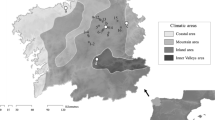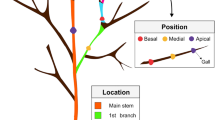Summary
We tested the Enemy Impact Hypothesis, which predicts that communities of one tropic level are organized by the tropic level above. In the case of gallforming insect communities, the hypothesis predicts that gall morphology will diverge, minimizing the number of parasitoids shared among species. We used the monophyletic group of gallforming cecidomyiids (Asphondylia spp.) on creosote bush (Larrea tridentata) to test this hypothesis, predicting that species with thicker gall walls should exclude species of parasitoids with shorter ovipositors and have lower levels of parasitism. Of 17 parasitoid species reared from Asphondylia galls on creosote bush, 9 accounted for over 98% of parasitism. Seven of these 9 species had ovipositors long enough to penetrate 10 of 13 gall morphs measured. There was no significant relationship between gall wall thickness and number of associated parasitoid species (r 2=0.01, P>0.05, n=13). There was no relationship between gall wall thickness and types of parasitoid species colonizing galls: parasitoids with the shortest ovipositors colonized all types of gall morphs and were dominant members of the parasitoid assemblages in galls with the thickest walls. Ultimately, there were no significant differences in percent parasitism among Asphondylia species, regardless of gall wall thickness. We found no difference in numbers of associated parasitoids or percent parasitism in galls with different textures (e.g. hairy versus smooth), different locations on the plant or different phenologies. Our results suggest that enemy impact has not influenced the diversity of this gall community. Gall wall thickness, phenology, location on the plant and surface structure do not appear to influence the distribution of parasitoid species. Other explanations are offered to account for diversity in gall morphology among these species.
Similar content being viewed by others
References
Abrahamson WG, Weis AE (1987) Nutritonal ecology of arthropod gall makers. In: Slanky F, Rodriguez JG (eds) Nutritional ecology of insects, mites and spiders. John Wiley and Sons, Inc. New York
Askew RR (1961) On the biology of the inhabitants of oak galls in Cynipidae (Hymenoptera) in Britain. Trans Soc Brit Entomol 14:237–268
Askew RR (1980) The diversity of insect communities in leafmines and plant galls. J Anim Ecol 49:817–829
Cornell HV (1983) The secondary chemistry and complex morphology of galls formed by the Cynipidae (Hymenoptera): How and why? Am Midl Nat 110:225–234
Cornell HV (1985) Local and regional richness of cynipine gall wasps on California oaks. Ecology 6:1247–1260
Darlington A (1975) The pocket encyclopedia of plant galls in color. Blandford, Poole, UK
Felt EP (1940) Plant galls and gall makers. Comstock, Ithaca, N.Y.
Goeden RD, Louda SM (1976) Biotic interference with insects imported for weed control. Ann Rev Ent 21:325–342
Gordh G, Hawkins BA (1982) Tetrastichus cecidobroter (Hymenoptera: Eulophidae), a new phytophagous species developing within the galls of Asphondylia (Diptera: Cecidomyiidae) on Atriplex (Chenopodiaceae) in southern California. Proc Entomol Soc Wash 84:426–429
Hawkins BA (1988) Do galls protect endophytic herbivores from parasitoids? A comparison of galling and non-galling Diptera. Ecol Entomol (in press)
Hawkins BA, Goeden RD (1982) Biology of a gall-forming Tetrastichus (Hymenoptera: Eulophidae) associated with gall midges on saltbush in southern California. Ann Ent Soc Am 75:444–447
Hawkins BA, Goeden RD (1984) Organization of a parasitoid community associated with a complex of galls on Atriplex spp. in southern California. Ecol Entomol 9:271–292
Hawkins BA, Lawton JH (1987) Species richness for parasitoids of British phytophagous insects. Nature 326:788–790
Hawkins BA, Goeden RD, Gagne RJ (1986) Ecology and taxonomy of the Asphondylia spp. (Diptera: Cecidomyiidae) forming galls on Atriplex spp. (Chenopodiaceae) in southern California. Entomography 4:55–107
Jones D (1983) The effect of host density and gall shape on the survivorship of Diastrophus kincaidii (Hymenoptera: Cynipidae). Can J Zool 61:2138–2142
Jones RG, Gagne RJ, Barr WF (1983) Biology and taxonomy of the Rhopalomyia gall midges (Diptera: Cecidomyiidae) of Artemesia tridentata Nuttall (Compositae) in Idaho. Cont Am Ent Inst 21:1–90
Krombein KV, Hurd PD, Smith DR (eds) (1979) Catalog of Hymenoptera in America North of Mexico. Smithsonian Institution Press, Washington, D.C.
Lawton JH (1978) Host-plant influences on insect diversity: the effects of space and time. Symp R Entomol Soc Lond 9:105–125
Lawton JH, Strong DR (1981) Community patterns and competition in folivorous insects. Am Nat 118:317–338
Mamaev BM (1968) The evolution of gall forming insects-gall midges. The British Library, West Yorkshire, England
Moser JC (1965) The interrelationships of three gall makers and their natural enemies on hackberry (Celtis occidentalis L.). New York State Museum and Science Service, Bull. No. 402, U.S.N.Y., Albany
Nie NH, Hull CH, Jenkins JG, Steinbrenner K, Bent DH (1975) Statistical package for the social sciences. McGraw-Hill Book Co., New York
Price PW (1980) Evolutionary biology of parasites. Princeton Univ., Princeton
Price PW (1988) Inversely density-dependent parasitism: the role of plant refuges for hosts. J Anim Ecol 57:89–96
Price PW, Clancy KM (1986) Interactions among three torphic levels: gall size and parasitoid attack. Ecology 67:1593–1600
Price PW, Bouton CE, Gross P, McPheron BA, Thompson JN, Weis AE (1980) Interactions among three tropic levels: influence of plants on interactions between insect herbivores and natural enemies. Ann Rev Ecol Syst 11:41–65
Price PW, Fernandes GW, Waring GL (1987) Adaptive nature of insect galls. Environ Ent 16:15–24
Rohlf FJ, Sokal RR (1969) Statistical tables. W.H. Freeman and Co., San Francisco
Stander JM (1970) Diversity and similarity of benthic fauna of Oregon. M.S. Thesis. Oregon State Univ., Corvallis, Oregon. p 72
Strong DR, Lawton JH, Southwood TRE (1984) Insects on plants. Harvard Univ. Press, Harvard
Waring GL (1987) Plant stress and the ecology of gallforming insects. PhD. Dissertation,Northern Ariz. Univ, Flagstaff, AZ
Washburn JO, Cornell HV (1981) Parasitoids, patches and phenology: their possible role in the local extinction of a cynipid gall wasp population. Ecology 62:1597–1607
Weis AE, Abrahamson WG (1986) Evolution of host-plant manipulation by gall makers: ecological and genetic factors in the Solidago-Eurosta system. Am Nat 127:681–695
Weis AE, Abrahamson WG, McCrea KD (1985) Host gall size and oviposition success by the parasitoid Eurytoma gigantea. Ecol Ent 10:341–348
Zar JH (1984) Biostatistical analysis. Prentice-Hall, Inc., Englewood Cliffs, New Jersey
Author information
Authors and Affiliations
Rights and permissions
About this article
Cite this article
Waring, G.L., Price, P.W. Parasitoid pressure and the radiation of a gallforming group (Cecidomyiidae: Asphondylia spp.) on creosote bush (Larrea tridentata). Oecologia 79, 293–299 (1989). https://doi.org/10.1007/BF00384307
Received:
Published:
Issue Date:
DOI: https://doi.org/10.1007/BF00384307




